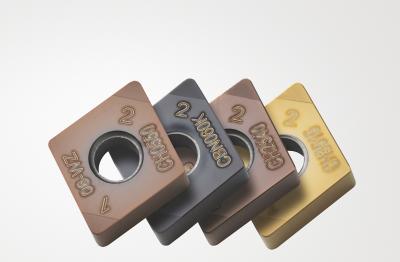
Seco Tools has expanded its family of PCBN insert grades to cover the entire spectrum of hard turning applications. Using a new bimodal substrate and nanolaminate coating process, these new inserts extend tool life and increase productivity in a broader range of applications.
Seco’s PCBN grade chain for materials ranging from ISO H05 to H35 consists of CH0550, CBN060K, CH2540 and CH3515 and is designed specifically for turning hardened steels. They incorporate advanced coatings and a bimodal substrate with coarser grain materials, along with optimized cutting edge profiles for long and predictable machining performance.
CH0550 provides prolonged wear resistance in high-speed continuous cut H05 operations. CBN060K excels in continuous to slight interrupted cuts in H15 applications.
CH2540 offers unparalleled performance in continuous and moderate interrupted cuts in the H25 area. CH3515 exhibits extreme toughness handling heavy interruptions in H35 operations.
Each of Seco’s PCBN grades is available in common ISO insert geometries in both metric and imperial specifications. High-feed wiper geometry options are available to further enhance performance.
Contact Details
Related Glossary Terms
- hard turning
hard turning
Single-point cutting of a workpiece that has a hardness value higher than 45 HRC.
- polycrystalline cubic boron nitride ( PCBN)
polycrystalline cubic boron nitride ( PCBN)
Cutting tool material consisting of polycrystalline cubic boron nitride with a metallic or ceramic binder. PCBN is available either as a tip brazed to a carbide insert carrier or as a solid insert. Primarily used for cutting hardened ferrous alloys.
- turning
turning
Workpiece is held in a chuck, mounted on a face plate or secured between centers and rotated while a cutting tool, normally a single-point tool, is fed into it along its periphery or across its end or face. Takes the form of straight turning (cutting along the periphery of the workpiece); taper turning (creating a taper); step turning (turning different-size diameters on the same work); chamfering (beveling an edge or shoulder); facing (cutting on an end); turning threads (usually external but can be internal); roughing (high-volume metal removal); and finishing (final light cuts). Performed on lathes, turning centers, chucking machines, automatic screw machines and similar machines.
- wear resistance
wear resistance
Ability of the tool to withstand stresses that cause it to wear during cutting; an attribute linked to alloy composition, base material, thermal conditions, type of tooling and operation and other variables.
- wiper
wiper
Metal-removing edge on the face of a cutter that travels in a plane perpendicular to the axis. It is the edge that sweeps the machined surface. The flat should be as wide as the feed per revolution of the cutter. This allows any given insert to wipe the entire workpiece surface and impart a fine surface finish at a high feed rate.

